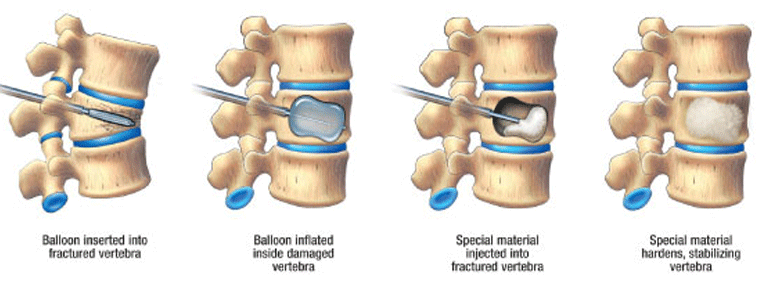Kyphoplasty
Kyphoplasty is similar to vertebroplastyin the treatment of an acute vertebral compression fracture. The major difference is that kyphoplasty includes the added step of utilizing a balloon to expand and restore the height of the vertebra. The process of inflating the balloon inside the fractured vertebra also creates a space in the vertebra for the cement to be placed. Both procedures place an internal cement cast inside the fractured vertebra, thus alleviating back pain. However, the kyphoplasty helps to maintain the height of the vertebra and the alignment of the spine.
Indications
Kyphoplasty is indicated for the treatment of back pain due to an acute compression fracture of the spine that is painful with palpation over the affected vertebra. The compression fracture should have occurred no more than six weeks before the procedure. An MRI is helpful in detecting fluid in the vertebra indicating that the fracture is recent. This is to ensure that the procedure will be successful, and restoration of some height is possible. Those who have a chronic compression fracture or kyphosis for an extended period of time are generally not suitable candidates for kyphoplasty.
In some cases, the fractured vertebra can impinge on nerve roots causing a radiating nerve pain called a radiculitis. A series of epiduralsteroid injections can treat the nerve pain as a supplementary procedure to kyphoplasty. (See epidural steroid injection.)
Procedure
This procedure can be performed in a same day surgical center or operating room under deep sedation to assure comfort. Local anesthesia is also used to help alleviate pain during the procedure. A small incision will be made over the vertebra or vertebrae that requires attention. A tube is then placed inside the incision, and special moving x-rays, called fluoroscopy, help the doctor guide the tube into the compressed vertebra.
Through this tube, a small balloon is introduced into the compressed space. Using the fluoroscopy for visualization, the balloon is carefully inflated until it elevates the vertebra towards its previous height. However, full height recovery may not be possible, even with this procedure. In addition, the soft bone inside the vertebra is compressed, creating a space for cement to be placed. The doctor will remove the balloon and, using low pressure instruments, will inject polymethylmethacrylate. This is a cement-like material that fills the void created by the balloon and hardens quickly to stabilize the spine. Once the material hardens, the equipment is removed and the incision is closed.
Kyphoplasty Video:
Recovery
You will be taken to recovery and watched closely for a few hours following the procedure. Most patients will be able to return home the same day, but in some cases, the doctor may want you to stay in the hospital overnight for further observation.
Many patients feel relief from their back pain immediately, but for some it may take a few days, depending on the nerve involvement. You should be able to move better than before and experience less pain. You will not be able to drive for a few days after the kyphoplasty, so it is important to arrange transportation to and from the hospital and doctor’s visits. Most patients can return to normal activities within one to two days, but you should not lift heavy object for at least six weeks. In general, kyphoplasty is a safe procedure. The possible risks include bleeding, infection, reactions to the anesthesia, and leakage of the cement into the surrounding tissues. However, these complications are rare, and most patients experience an increase in their quality of life following kyphoplasty.
References
Spine-Health; Description of Kyphoplasty Procedure; Courtney W. Brown, MD and Douglas C. Wong, MD; March 2009
http://www.spine-health.com/treatment/back-procedure/description-kyphoplasty-procedure



